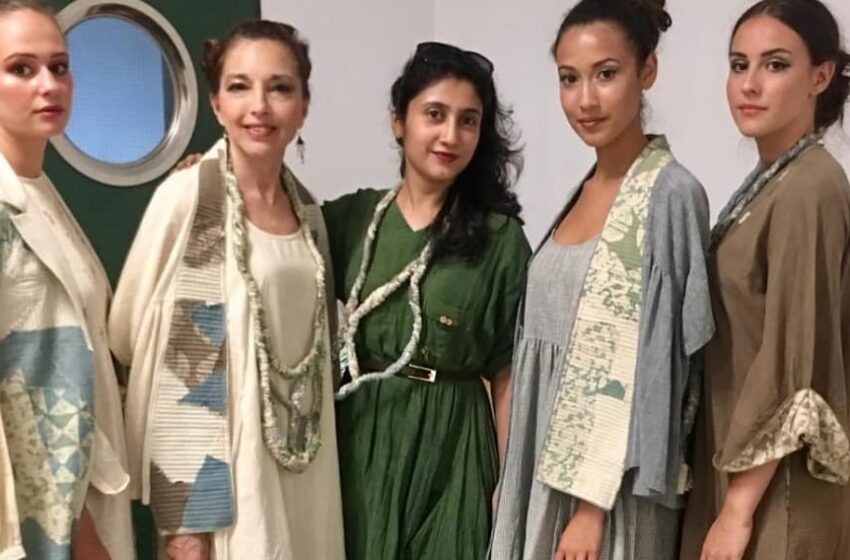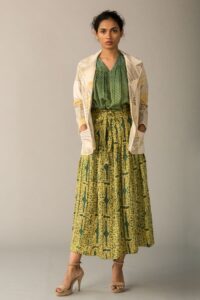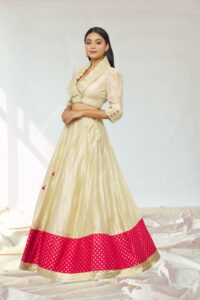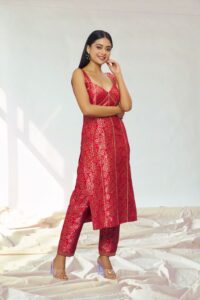‘Ek Katha caters to affordable luxury sustainable section in domestic market’

Madhumita Nath, Founder-Designer, Ek Katha, with the models
Rajkumari Sharma Tankha
Born into a family of engineers and scientists, Madhumita Nath was a design enthusiast all along. No wonder, she went on to study Fashion Design at National Institute of Design, Ahmedabad after completing her school. But she took more than a decade to start her venture, Ek Katha Clothing. While she had the urge to start her venture while she was studying at NID during the early 2000’s, she didn’t have the necessary courage to take this life-defining step back then.
Ek Katha Clothing was launched in 2016. “There was a huge gap between my pass out year (2005) and starting my venture. Marriage and motherhood happened during this period. But soon I felt a gnawing emptiness – I couldn’t be just existing, I wanted more out of life,” she says.
Impelled by this desire, Madhumita took a solo trip to Kutch wherein she met some ace artisans like Shakeel Khatri (Batik) and their promoters like Kuldeep Gadhvi. The trip made her realise that Batik is what she wanted to work around.
She then began creating small capsule collections in desi cotton (organic Kala Cotton from Gujarat) and Batik, presenting these at pop up events. “While I was figuring out our Product Market Fit, business, scaling up, taking risks, nothing of the sort was in the horizon,” she says.
At the Lakme Fashion Week in 2019, she was chosen as Gen Next which prompted her to create her first fashion collection. “I also got organic connects which led to few export orders and stocking at Multi Designer stores across India,” she says. But just as things were looking up for her, Covid happened, “followed by 2.5 years of major low”.
“It is only now that I am seriously thinking of scaling up my business and looking forward to Omni channel sales channel expansion, online, other marketplaces and Offline brick and mortar formats,” says Madhumita, who is disrupting the market with her ready-to-wear women’s clothing – dresses, blouses, tunics, jackets, skirts and pants.
Excerpts from an interview:
How did the family of scientists welcome your decision to enter the world of design?
My family, especially my Baba (my father), has been very proud of what I chose to study and what I have chosen to do with my abilities and skill sets. I would like to believe that they are proud of the ‘black sheep’ and the fact that I can stand my own in the family of PhDs and IITians.

How much investment went into it – is it bootstrapped or angel invested?
We are bootstrapped with family helping me with funds. We do have plans of offline retail expansion which would need outside funding. We are looking for angel investors and also at partnerships for individual stores. Team building, marketing and design and product development would get a big boost post funding and will help us scale up.
How did you connect with the artisans, and which all states do they belong to?
When I started off it was just artisans from Gujarat. Then through my network of friends in the field I connected to a few more, some in West Bengal, Rajasthan, Odisha, Chanderi (MP) and Bangalore, Nagpur, gradually over the years the network expanded. Now weavers and craftsmen get in touch with me through Instagram. Social Media has been a boon is connecting people and businesses. These are artisan entrepreneurs.

How has been your experience as a women business-owner?
I have had a very natural and organic connect with artisans. They have never treated me in any way which is prejudiced or hurtful to a woman. Especially when it comes to Batik clusters in Kutch, I just realised that building good relationships with them is what comes naturally. You need to think from their standpoint as well.
How is Ek Katha different from the host of similar other brands?
Most of our competitors in sustainable clothing are selling majorly in the West with hardly any D2C presence in India. I see a gap in the designer affordable luxury sustainable section in the domestic retail space. There is a demand for Ethnic Indian wear that we all know and how wedding /bridal is a huge market, but there is also a space wherein indo western can fit in as the buyer is trying to make a statement with her choice.
Also each competitor brand has a very distinct aesthetic which is guided by the craft they have chosen to adopt and we too have figured out our visual vocabulary through handloom and Batik. Having our own space aesthetically is important as fashion is about ‘wanting to add desirability’, it’s not a need.
I believe there is a huge offline retail space waiting to be explored.

Which is your hot-selling product?
We have received good traction for our organza corded maxi skirts which can be worn in an unconventional way for the Indian festivals/weddings and can be stylised in an Indo-Western Western manner as well. The jackets do well as they are versatile and layering your attire with an overlay is the simplest way of making a difference.
From which area does Ek Katha get the maximum demand, and for which products?
Mumbai, Hyderabad, Bangalore and Delhi are the top four cities in India where we have seen demand for our products. The other cities besides these are Jodhpur, Ludhiana, Gurugram, Chennai and Pune.
These insights are based on our newly launched website (September 2022). Based on these we are planning our marketing as well as retail expansion plans. Many buyers purchase after touching and feeling the cloth. Only after they are sure do they shop online. So, an omnichannel experience is what we would like to offer.

Looking back, how do you view your journey so far?
The design journey started a long time back, but my entrepreneurial journey has just started. I would like to look back without any regrets and only learnings which propels me to take up the challenges to scale up in a crowded fashion space and find our niche and space under the sun.

Where do you see yourself, say five years from now?
I see myself taking my brand all over the country, making it accessible to buyers looking for hand woven, handcrafted and yet fashionably elevated pieces in Tier 1 and Tier 2 cities. I also visualise getting into foreign markets (through B2B channels).

